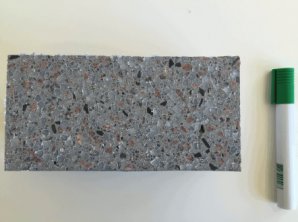Sweden: A new polythene-B4C based concrete for shielding

Photo of a cross-section of PE-B4C-Concrete, the marker is shown for reference.
Shielding plays an important role at neutron sources for both radiation safety and for minimizing background noise in neutron experiments. (see our Simulating Laminate Shielding Concepts article) Shielding is regularly made from concrete, which contains hydrogen atoms that help to slow down neutrons.
A team at the ESS in Sweden, led by Phillip Bentley, wanted to see if they could improve the neutron shielding properties of a standard concrete. They added extra hydrogen into the concrete in the form of polyethylene (PE) beads and also included boron carbide, another substance known to inhibit the transmission of neutrons.
The concrete mixing was performed by the Danish Technological Institute in Denmark. They determined the best ratios that produced a homogenous distribution of polyethylene throughout the concrete and replaced some of the sand in the composition with B4C as they have similar grain sizes and density.
The new PE-B4C-concrete was then compared to a reference concrete. It had a 15% lower mass density and was a bit weaker than the standard composition. Shielding measurements were performed on the concrete using a Time of Flight (TOF) technique, known as neutron tagging, at Lund University in Sweden.
The PE-B4C concrete had an improved shielding performance in the MeV neutron energy range, letting 40% less neutrons through than standard concrete. At lower neutron energies, it is expected that the improvement in shielding is even more pronounced. These experimental findings agreed well with Geant4 simulations performed in parallel.
Activation studies of the two concretes were performed at MTA EK (see our Activation Studies article) and suggest that the new polyethylene based concrete has lower activation values than the standard concrete.
In an additional study, the team investigated the particle self-shielding effect of different sized B4C grains. This is where, if a B4C grain is large enough, the outer region of the grain will shield the inner region and render it ineffective. Five different batches of the PE-B4C concrete were mixed using different B4C grain sizes, although the total weight fraction of B4C was always kept the same. The measurements were carried out using a 2 Å neutron beam at the JEEP II reactor at the Institute for Energy Technology in Kjeller, Norway. These measurements were then compared to Geant4 simulations, again agreeing well. Overall, the smallest grain sizes yielded the best shielding performance of the concrete but, when choosing shielding material, a balance must be found between this and the increased price and potentially decreased stability of the concrete as the grain size gets smaller.
This new potential shielding material could be used as both bulk shielding at spallation neutron sources or in specific beamline components. It could also be useful in reactor- or accelerator-based neutrons facilities.
References: A Polyethylene-B 4C based concrete for enhanced neutron shielding at neutron research facilities, D. D. DiJulio, C. P. Cooper-Jensen, H. Perrey, K. Fissum, E. Rofors, J. Scherzinger, P. M. Bentley
Measurements and Monte-Carlo simulations of the particle self-shielding effect of B4C grains in neutron shielding concrete D. D. DiJulio, C. P. Cooper-Jensen, I. Llamas-Jansa, S. Kazi, P. M. Bentley
Acknowledgements: Douglas Di Julio, ESS
Back to The Road to the ESS
Other articles: E-tools, Simulating Laminate Shielding Concepts, Activation Studies